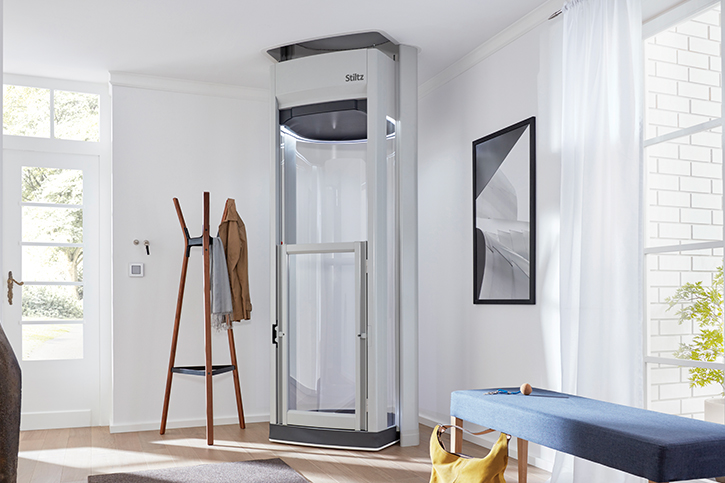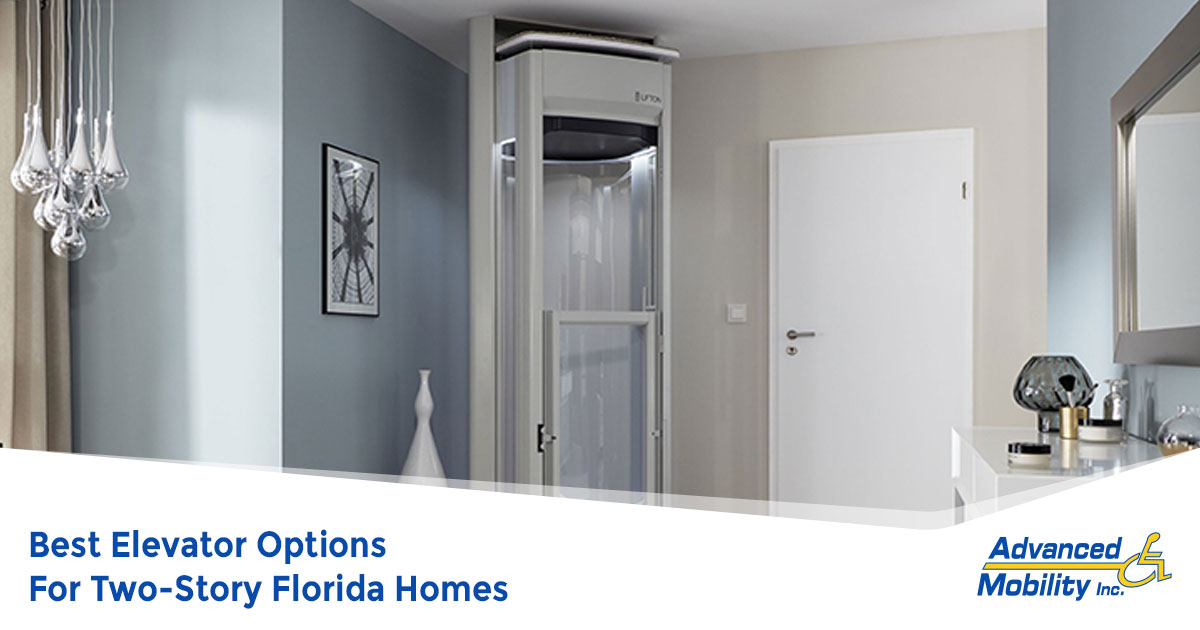Residential elevators enhance both convenience and functionality in two-story homes, making vertical movement a seamless part of everyday living. They provide improved accessibility while maintaining the home’s layout and aesthetic.. As a Florida homeowner, adding a residential elevator can help support aging in place, accommodate mobility needs, and increase property value.
Here are some of the best elevator options for two-story Florida homes:

1. Stiltz Duo Home Elevator
The Stiltz Duo Home Elevator is ideal for Florida homes where space is tight. Its compact structure fits into corners or small rooms without requiring load-bearing walls or major changes to your layout. A self-supporting frame keeps construction minimal, which helps maintain your home’s original design.
This residential elevator fits one or two passengers and runs on a standard 220V outlet. It stays quiet in operation, so it doesn’t interfere with daily activities or conversations. Why should adding convenience disrupt your space when a low-profile solution like this exist?
The Duo offers freedom of movement between floors while preserving the character of your home. It keeps things simple without cutting corners on function. You get comfort and access without the need for bulky equipment.
2. She-Tech Home Elevator
The She-Tech brings a traditional look to your two-story home with the strength and performance of a traction drive system. It doesn’t rely on hydraulics, which gives you more room for style and design. With a 950-pound capacity, it handles guests, furniture, and daily needs with ease.
Inside, you’ll find wood-paneled walls, clean detailing, and finishes you can tailor to your home. Everything from the interior to the controls is designed to feel natural. What if your elevator could blend into your décor instead of standing out?
The She-Tech supports both function and visual appeal. It adds long-term value and comfort while preserving the feel of a classic home. This residential elevator doesn’t just carry you between floors as it becomes part of the home itself.
3. Stiltz Trio Wheelchair Elevator
The Stiltz Trio Wheelchair Lift gives you more room to move, especially if you use a wheelchair, walker, or need assistance. Its larger cab allows easier turning and entry, while the through-car feature lets you enter from one side and exit from the other. This layout supports smooth movement across your home without the need to backtrack.
Safety features like sensors and a backup system are built in to protect against power loss or unexpected obstacles. Isn’t it reassuring to know your elevator can think ahead when you can’t? With no shaft required, installation stays flexible and less invasive to your space.
This residential elevator offers more than function. It improves how you move through your home and adds comfort without drawing attention to itself. The Trio simply fits into your routine without creating new limitations.
What to Consider When Choosing Residential Elevators
Before choosing residential elevators for your two-story home, take time to evaluate more than just the style or finish. How well your elevator fits your lifestyle depends on details like power supply, available space, or the number of people using it daily. Knowing what matters most can help you make a choice that lasts and fits naturally into your home.
Space Requirements
Start by measuring the available floor space where the elevator will go. Closets, stairwells, or unused corners often offer enough room, especially if you choose a compact model. Still, don’t overlook how the elevator will affect the surrounding layout and how people move through nearby areas.
You probably want a location that won’t block natural pathways or take away from the openness of your space. The goal is to add function without compromising comfort or movement. If the elevator sits too close to entry points or limits furniture placement, it may cause daily frustration.
Your installer can help you assess what’s possible with the structure you already have. In many cases, smaller lifts require less prep and blend more easily into tight areas. When in doubt, prioritize spots with high access value and minimal structural change.
Load Capacity and Occupant Needs
Different elevators support different weight limits and passenger counts. Think about who will use it regularly. Is it just you, or will you need space for family, guests, or a caregiver?
If accessibility is a concern, choose a model that accommodates mobility devices or medical equipment. The right features help everyone use the elevator safely and without struggle.
- Accommodates wheelchairs, walkers, or medical support devices
- Supports two or more passengers with comfortable spacing
- Allows for caregiver-assisted entry and exit when needed
Power Source and Energy Use
Residential elevators may run on a standard 110V or higher-capacity 220V connection. Smaller models tend to use less power and plug into existing outlets. Larger lifts often require dedicated circuits and more planning.
Energy use affects monthly costs, especially in homes where the elevator runs daily. A more efficient drive system reduces electricity use without lowering performance. Ask yourself how much traffic the elevator will get and what power setup you’re comfortable with.
If you prefer low-maintenance equipment that doesn’t spike your utility bill, look at energy-efficient drive options. These can still handle everyday use without overloading your system.
Installation Time and Disruption
How the elevator fits into your home depends on whether you’re building new or retrofitting an existing structure. Pre-construction installs offer more freedom in layout and design choices. Retrofitting requires adjusting to what’s already built, which can extend the timeline.
Ask about the duration of installation and how it might affect your living space. Will you need to move out temporarily, or can work happen while you stay home? Knowing this helps you plan around daily routines or family schedules.
Smaller models with self-supporting frames usually require less structural work. This keeps installation time shorter and reduces the impact on nearby rooms.
Florida-Specific Considerations
Living in Florida means accounting for the local environment and regulations. Moisture, wind, and salt air create challenges other states may not face.
When evaluating residential elevators, consider the following:
- Materials should resist humidity and corrosion from coastal air
- Units must comply with Florida’s building and elevator codes
- Consider battery backups or hurricane-rated features for storm readiness
- Installer should be familiar with regional zoning and permit requirements
Upgrade Your Florida Home with the Right Elevator Partner
Adding a residential elevator transforms how you move, live, and age in your two-story home. With a wide range of modern, space-saving, and accessible options, Advanced Mobility Inc. delivers tailored solutions that fit your lifestyle and home design. Our team can help you choose, install, and maintain an elevator that meets your needs today and adapts for tomorrow.
Give us a call today at 954-888-9292 and take the first step toward safer, smarter living with quality residential elevators.








